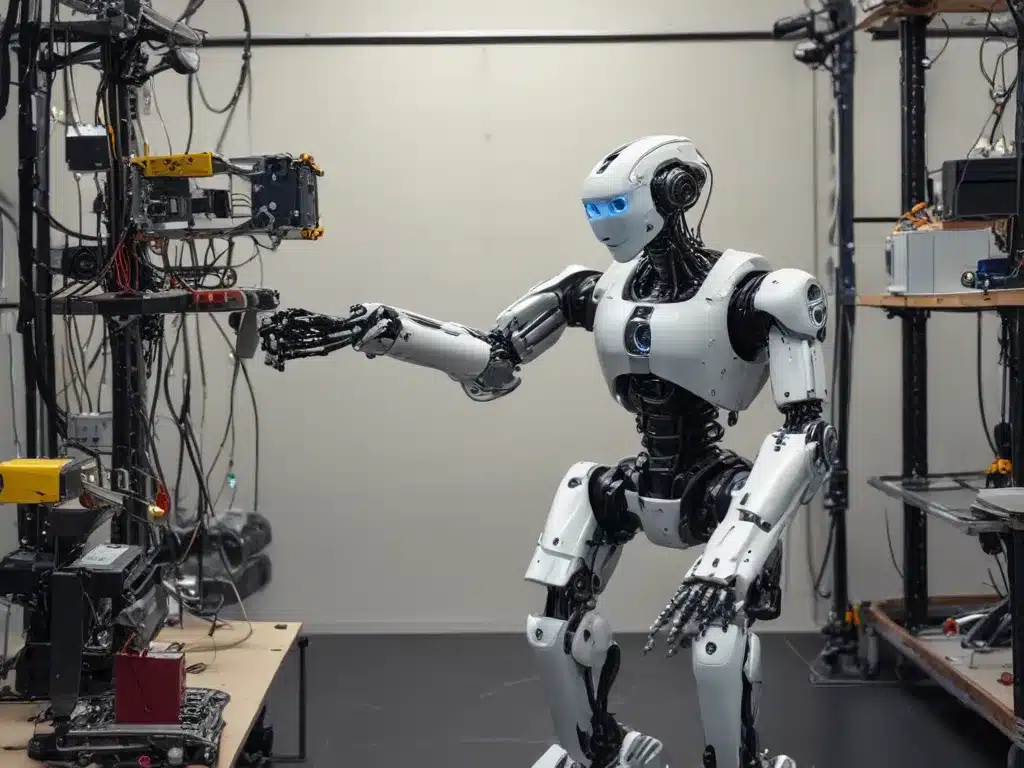
The Rise of Mind-Powered Machines
Imagine a world where the mere power of thought could manipulate complex machinery with unparalleled precision. This isn’t some far-fetched sci-fi fantasy – it’s the remarkable reality of thought-controlled robots. As an engineer, I’ve been fascinated by the incredible advancements in this field, and I can’t wait to share my insights with you.
You see, the concept of using our brainwaves to control technology might sound like something straight out of a futuristic movie, but it’s actually been in development for decades. Researchers have been tinkering away, determined to unlock the secrets of the human mind and harness its incredible potential. And let me tell you, the results are nothing short of mind-blowing (pun very much intended).
Unlocking the Power of the Mind
The key to these thought-controlled robots lies in the intricate network of neurons firing within our brains. Each time we have a thought, electrical signals are generated, and these signals can be detected and interpreted by specialized sensors. By training these sensors to recognize specific patterns of brain activity, we can essentially teach a robot to respond to our mental commands.
It’s like your brain is the control centre, and the robot is the obedient servant, ready to carry out your every whim. Want to move a robotic arm? Just think about it, and voila – the arm springs into action. Need to operate a power tool with precision? Concentrate your mind, and the machine will obey your mental directives.
The Potential Applications
The implications of this technology are truly astounding. Imagine the possibilities for individuals with physical disabilities or mobility challenges. These thought-controlled robots could give them a new level of independence and control over their environment. No longer would they be limited by the constraints of their bodies; instead, they could harness the power of their minds to manipulate the world around them.
But the applications extend far beyond the realm of assistive technology. In industries like construction, where precision and efficiency are paramount, thought-controlled robots could revolutionize the way we approach complex tasks. Picture a construction worker, donning a specialized headset, guiding a robotic arm with the mere power of their thoughts, seamlessly maneuvering tools and materials with unparalleled dexterity.
The Challenges and Advancements
Of course, developing this technology has not been without its challenges. Accurately interpreting the brain’s electrical signals and translating them into precise robotic movements is no easy feat. Researchers have had to grapple with issues like signal noise, individual variations in brain activity, and the complexities of motor learning.
But the progress has been remarkable. Advancements in brain-computer interface (BCI) technology, machine learning algorithms, and sensor miniaturization have all contributed to the steady improvement of thought-controlled robots. And as the field continues to evolve, we’re likely to see even more impressive feats of mind-powered machinery.
A Glimpse into the Future
I can only imagine what the future holds for this technology. Perhaps one day, we’ll see construction workers effortlessly guiding robotic bricklayers or operating autonomous excavators with the power of their thoughts alone. Or maybe individuals with spinal cord injuries will be able to control their entire living environments through the simple act of thinking.
The possibilities are truly endless. And as an engineer, I can’t help but feel a sense of excitement and wonder at the prospect of what’s to come. This is the kind of groundbreaking innovation that really captures the imagination and pushes the boundaries of what we thought was possible.
Ethical Considerations
Of course, with any transformative technology, there are important ethical considerations to address. As thought-controlled robots become more advanced and widespread, we’ll need to grapple with questions of privacy, consent, and the potential for misuse. How do we ensure that these systems are secure and protected from hacking or unauthorized access? How do we safeguard the rights and autonomy of the individuals using them?
These are complex issues that will require robust dialogue and collaboration between researchers, policymakers, and the general public. But I’m confident that as a society, we can find the right balance – one that harnesses the incredible potential of thought-controlled robots while also upholding our core values and principles.
Conclusion
As I look back on the journey of thought-controlled robots, I’m struck by the sheer brilliance and ingenuity of the scientists, engineers, and innovators who have dedicated their careers to pushing the boundaries of what’s possible. Their work has the power to truly transform lives and revolutionize entire industries.
And as someone who’s had the privilege of witnessing these advancements firsthand, I can’t help but feel a deep sense of excitement and optimism for the future. Who knows what other incredible feats of mind-powered technology are just around the corner? The possibilities are truly limitless.
So, my friends, keep your minds open and your thoughts focused – the future of thought-controlled robots is bright, and it’s coming sooner than you might think. Let’s embrace this incredible technology and see where it takes us.





